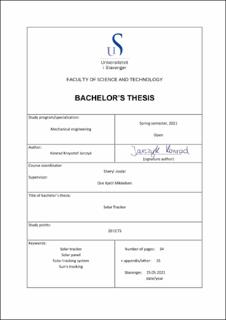| dc.description.abstract | The global energy system is currently undergoing a significant change from fossil fuels to renewable energy. Depending on the country and its resources, one of the most efficient, reliable methods of producing energy is obtaining electricity from the sun. Going a step further, most typical solar farms are not using the full potential of solar panels. This study aims to determine why solar farms are widespread in some countries and some other countries do not use them at all. Specifically, it investigates whether and how much the geographical location affects the performance of the solar tracker. In this context, a solar tracker is defined as a device, which directs solar panels or modules toward the sun’s radiation. By changing its orientation throughout the day, the solar tracker follows the sun’s path on the horizon to maximize electricity production.
To test the hypothesis that how fast the costs of the self-designed solar tracker can be reimbursed, depending on its geographical location, first, the solar tracker was designed and tested against possible loads. For controlling the dual-axis solar tracker, a programmable logic controller with a self-programmed algorithm for tracking the sun was chosen. Next, the solar tracker’s production costs were estimated, and with data about sun hours in two individual places, the reimbursement times were calculated. The results showed a significant difference in produced energy between these two chosen locations within Europe, which resulted in much deviated times needed to reimburse the solar tracker costs.
These results suggest that the performance of the solar tracker strictly depends on its geographical location. On this basis, it can be concluded that the solar tracker doesn’t do good at all the destinations, and the potential future investor should consider all possible options before deciding on such a solution. | |
